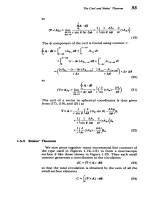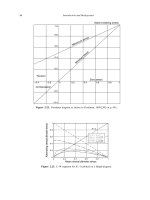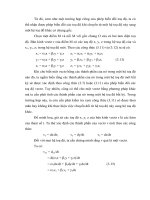McGraw-Hill Build a Remote Controlled Robot Part 7 pps
Bạn đang xem bản rút gọn của tài liệu. Xem và tải ngay bản đầy đủ của tài liệu tại đây (163.38 KB, 15 trang )
motor. Figure 4-5 shows how a star lever looks. For this appli-
cation you will need star levers that must be modified by
removing four of the star’s legs. What you end up with is a
straight bar like that in Fig. 4-6. The bar will trip a bank of
leaf switches on either side of the servo.
58 CHAPTER FOUR
FIGURE 4-6. Modified star lever.
FIGURE 4-5. Star lever.
In order to be tripped, the leaf switches must line up with
the trip bar on the servo. This is accomplished by stacking
10- ϫ 1- ϫ 1/8-inch strips of wood along each side of the ser-
vos, then mounting the leaf switches on the strip. Figure 4-7
shows where to mount the leaf switches on the wooden strip
in relation to the servos. Once the leaf switches are mounted,
connect the servos to the remote control system’s receiver and
by using the transmitter, check to see if the trip bar is activating
the switches properly. The order in which the servos are
wired to the receiver is not important at this time; however,
when the receiver is mounted, the sequence will be detailed
so that the control stick on the transmitter activates the
proper servo.
Once the servos and leaf switches are operating properly,
the barrier strips and fuse box for the remote control system
can be mounted to the motherboard. Figure 4-4 shows where
to mount these components. With all components mounted,
the next step is to wire them together.
REMOTE CONTROL SYSTEM 59
FIGURE 4-7. Leaf switch mounting.
WIRING THE MOTHERBOARD
Before you wire the motherboard, cut two notches on each
side of the motherboard so the wires will not go past its edge.
Figure 4-8 shows how to wire together the components on the
motherboard. There are two main rows of barrier strips on the
motherboard; the first row is numbered. These numbers cor-
respond with numbers on the tabs of the leaf switches; simply
wire the matching numbers together. In some cases more than
one wire will go to one post on the barrier strip. Use the half
of the barrier strip closest to the leaf switches. The color wire
used is indicated on the leaf switch: R ϭ red, B ϭ black. The
other row is where the motorized wheel and horn will be con-
nected; they too use the matching number system.
The second row is divided into two parts called power
grids. The first 8 post (which is one complete barrier strip) is
called the positive grid and is where the positive lead of the
battery is connected and where all the positive or red wires
from Questor’s electronics will be connected. The second 8
post is for the negative or black wires and is called the nega-
tive power grid. All the posts on the same side of each grid
must be wired together by one wire run from post to post. Be
sure not to run a wire between the positive and negative grids;
this will cause a short circuit. Figure 4-8 shows where the
wire runs. Later when other functions are wired, the instruc-
tions will say “wire to positive power grid and negative power
grid.” You can then connect those wires to any open post on
the grids. Figure 4-8 also shows four wires coming from the
positive grid to the fuse holder. These wires are all positive
and you should use red wires. Two more red wires run from
the opposite ends of two of the fuses directly to the post on
the leaf switch barrier strips. This is where the switch gets the
power to control two on/off functions in the robot. (The nega-
tive or black wire forms the function being controlled; in my
robot a horn is wired directly to the positive power grid.)
There are also two black wires running from the negative
power grid to the leaf switch barrier strips at post 8 and 2.
These are also shown in Fig. 4-8.
60 CHAPTER FOUR
Wires to the leaf switches and fuse holder will have to be
soldered. The wires that lead to the barrier strips should
have hooks bent at their ends so they can wrap around the
screws on the strip. After the board is wired, check it against
Fig. 4-8 because errors here can affect the function of the
rest of the robot. Also at this time, install four 20-amp fuses
in the fuse holder. These fuses help protect the robot’s com-
ponents from short circuits and overloads. Once the board
is wired and checked, the remote control receiver can
be mounted and the motherboard mounted in Questor’s
framework.
REMOTE CONTROL SYSTEM 61
FIGURE 4-8. Motherboard wiring diagram.
COMPLETING THE MOTHERBOARD
The remote control’s receiver and battery are mounted on the
underside of the motherboard. Using four screw-on hooks,
rubber bands and foam rubber, the receiver is held securely in
place. Figure 4-9 shows how to mount the receiver. The figure
is self-explanatory. The only thing to keep in mind is that the
servos must be wired to the receiver, so don’t mount the
receiver out of reach of the servo wires.
The order in which the servos are connected to the
receiver is very important to the control of the robot. When
both control sticks on the transmitter are pushed up, the
robot should move forward. If both sticks are pulled down,
the robot should run in reverse. The center or neutral posi-
tion is off and of course causes no movement of the robot.
If you have a third channel (and servo) in your remote con-
trol system, it should react to the sideways movement of one
of the control sticks on the transmitter. Table 4-2 lists
all of the control combinations used to operate Questor’s
functions.
It is not necessary to wire the motorized wheels to the
motherboard. To check this simply make sure that when the
sticks are pushed forward, the two servos controlling the
motorized wheels turn as shown in Fig. 4-10. If you have a
third servo a sideways movement of either stick should cause
the servo to activate it.
62 CHAPTER FOUR
FIGURE 4-9. Receiver and battery mounting.
INSTALLING AND WIRING THE
MOTHERBOARD
After the servos have been checked, the motherboard can be
installed in Questor’s framework and wired in place. To mount
the board you will need four 2- ϫ 2-inch aluminum corner
braces available at any hardware store. These are bolted in
place at the lower part of the robot’s upper framework where
the four bolts holding the two connecting pieces of the frame-
work are located. Figure 4-11 shows one angle in place. The
motherboard is then attached to these angles.
REMOTE CONTROL SYSTEM 63
TABLE 4-2. Control Combinations Using Transmitter Control Sticks
STICK POSITION ROBOT MOVEMENT
Right Left
Up Up Forward
Down Down Reverse
Center Center Stop
Up Down Circle right
Down Up Circle left
Up Center Turn right
Center Up Turn left
FIGURE 4-10. Proper servo activation to trip leaf switches.
Mark the holes for the aluminum angles on the mother-
board from underneath. Then remove the motherboard and
drill four 1/8-inch-diameter holes where marked, being careful
not to damage the parts already mounted on the motherboard.
Attach the motherboard to the angles using four 2-inch ϫ 1/8-
inch-diameter bolt, nut, and lockwasher sets.
Wiring the motherboard to the rest of the robot now
becomes a simple matter of matching number wires from
the motorized wheels and battery system to numbered posts
on the barrier strips. The two pots used to control the
robot’s speed are wired in at this time. One wire to each pot
comes directly from the fuse holder. Figure 4-12 shows the
connection to be made for the entire system. Since Questor
has yet to get his metal skin, the pots have no place to be
64 CHAPTER FOUR
FIGURE 4-11. Mounting angles for motherboard.
mounted on the robot, so for now simply tape them on the
platform at the rear of the robot where they will later be
mounted. Many of the spaces on the power grid barrier
strips will remain empty until later in the robot’s construc-
tion. As each new function is added to the robot, the empty
spaces will be used.
REMOTE CONTROL SYSTEM 65
FIGURE 4-12. Platform-to-motherboard wiring guide.
USING THE REMOTE CONTROL SYSTEM
The remote control system operates much in the same way as
the temporary control box did. In the control box the position
of the switches, up for forward, center for off, and down for
reverse, along with their combinations, dictated the direction
of the robot. With the remote control system, the control
sticks on the transmitter take the place of the switches of the
temporary control box. Unlike the temporary control box,
however, the transmitter cannot control the speed of the robot
because the pots are no longer at the controls but on the robot
itself. This means that you will have to calibrate Questor’s
motorized wheels and preset the robot’s speed before you use
the remote control system, a small price to pay for wireless
control. As I noted before, if your remote control system has a
third channel and thus a third servo, you could remotely con-
trol other robot functions. This extra servo is controlled by the
sideways movement of one of the control sticks.
Congratulations! You have just completed the last major
component of Questor’s construction! The rest of the book
covers various subsystems within Questor as well as the cos-
metic aspects of the robot’s construction. If you plan on build-
ing a duplicate of Questor, the following chapters detail the
rest of his construction. However, it is my hope that you will
use them as a guide to create your own individual robot
servant.
66 CHAPTER FOUR
ARMS AND
SUBSYSTEMS
I
n this chapter you will fabricate and assemble Questor’s
arms, drink dispenser, and head as shown in Fig. 5-1. Also
you will wire the vacuum cleaner completing that system.
Questor’s arms and drink dispenser will be built first because
they are interrelated to one another. The pump and tank for
the drink dispenser are housed inside the robot’s body while
the fluid outlet and control button are mounted on Questor’s
arm—more specifically, his left wrist. The drink dispenser
operates in a rather straightforward manner; pushing the con-
trol button on Questor’s wrist activates a small (and slightly
noisy) 12-volt pump. This pump draws fluid out of a 1-gallon
67
CHAPTER
FIVE
FIGURE 5-1. Arm, drink dispenser, and head.
Copyright 2002 The McGraw-Hill Companies, Inc. Click Here for Terms of Use.
container (a former milk container) and passes it via a tube
(fish tank air tubing) to an outlet on the underside of the
robot’s wrist below the control button. This way the person
getting the drink can control the amount dispensed.
Questor’s head consists of a 12-volt automobile dome light
and a cube shaped cover made of opaque ceiling light panels.
The head’s cover is the most delicate part of Questor and
should be fabricated, fitted, and then removed until the
68 CHAPTER FIVE
TABLE 5-1. Parts List
AMOUNT ITEM
1 Pushbutton SPST switch
1 12-volt dc pump
1 1-gallon milk container and cap
1 8-foot ϫ 2-inch PVC piping
4 2-inch-diameter PVC end-cap
2 2-inch-diameter PVC elbow
1 9 1/2- ϫ 9 1/2- ϫ 1/8-inch sheet of hardboard
4 1-inch ϫ 1/4-inch-diameter nut, bolt, and
lockwasher set
1 1- ϫ 2-foot section of sheet metal
6 1/4-inch-diameter washer
1 4-foot-length fish tank air tubing
2 Auto drink holder
1 Tube of silicone glue
1 1-slot fuse holder
1 12-volt auto dome light with switch
1 2- ϫ 4-foot sheet of ceiling light panel
6 1/8-inch ϫ 1/8-inch-diameter sheet-metal screw
# Miscellaneous wood screws
1 2-post barrier strip
# Rolls of 18-gauge wire, red and black
4 2- ϫ 2-inch corner brace
4 1-inch ϫ 1/8-inch-diamter bolt, nut, and
lockwasher set
robot’s final assembly to protect it from damage. The head
lights when a button (that should come with the auto dome
light kit) mounted on the robot is pushed. Questor’s head
serves two functions: One, as an attention getter, being that
the light is quite bright and, two, to illuminate the objects
being carried on his serving tray, The serving tray will be
mounted at the same time as Questor’s head, during final
assembly. The following sections will detail the construction
and installation of the robot’s arms, drink dispenser, and head.
ARMS
Questor’s arms are very simple to make and install; however,
care should be taken when fabricating them because errors in
the parts may affect the way the arms are mounted and how
level the serving tray sits on the arms. After viewing pictures
of Questor earlier in this book, the way the arms look and
their position should be rather obvious.
The arms are made from 2-inch-diameter PVC piping used
for plumbing (or robot arms). You will need two 8-inch and two
21-inch lengths of PVC. When you buy the PVC, also purchase
two 90-degree turn elbows and four end-caps. Figure 5-2 shows
what these parts look like.
When you cut the PVC piping, be sure to make your cuts as
straight as possible; I suggest you use a miter box to ensure
straight cuts. Cut the lengths of PVC according to Fig. 5-3 and
assemble them, as well as the elbows and end-caps, together
according to the figure. Be sure that the elbows and end-caps
fit snugly on the tubing because you will not be gluing or fas-
tening the parts together.
Once assembled, check to see that the arms are the same
height and length. Do this by standing them next to each other.
If the arms are not correct, all that may be needed is some tap-
ping or pulling of the end-caps so that they fit more snugly or
closer to the PVC pipe, or stick out farther from it. If the devi-
ation is large, you should disassemble the arm and recut a new
section of PVC piping. The piping is usually sold in eight-foot
ARMS AND SUBSYSTEMS 69
lengths, so you should have plenty if this occurs. After you
have the arms assembled, take a marker and draw a ring
around the pipes tracing the ends of the elbows and end-caps.
These lines will act as a guide, so if you disassemble the arms
for cutting and drilling, they can be reassembled correctly.
Now take one of the arms and hold it up against the side
of Questor’s upper framework so that the top edge and lower
arm lines up with the two 1/4-inch-diameter predrilled holes
on the framework as shown in Fig. 5-4. Mark where the holes
meet the elbow and arm and drill two 1/4-inch-diameter holes
where marked. Do the same with the other arm. Before the
arms can be bolted to the framework, a 3/8-inch hole must be
drilled on the outside of the lower part of the arm. Figure 5-5
70 CHAPTER FIVE
FIGURE 5-2. Elbow and end-cap.
ARMS AND SUBSYSTEMS 71
FIGURE 5-3. Arm assembly.
FIGURE 5-4. Mounting holes for the arm.
shows the location of this hole. The hole which lines up to the
1/4-inch-diameter hole drilled previously is used to access the
head of the bolt so you can turn it with a screwdriver when
attaching the arm to the framework.
Three more holes must now be drilled in Questor’s left
arm to accommodate parts used in the drink dispenser. One of
the two 1/4-inch-diameter holes is drilled along the inside of
the lower section of the arm and allows a tube from the drink
dispenser to pass into the arm. The second 1/4-inch-diameter
hole is drilled on the underside of the arm just behind the
front end-cap. This hole is where the outlet spout of the dis-
penser is located. The final hole drilled in the arm is located
directly above the hole for the outlet spout on the top of the
arm behind the end-cap; it allows wires for the control button
that switches the drink dispenser on and off to reach the switch
that will be mounted in the end-cap. The hole’s diameter
depends on the type of switch you have obtained. Figure 5-6
shows where the three holes are drilled on the left arm.
After all the holes have been drilled, there is one final
preparation to be made. Two small squares must be cut from
the ends of the two upper pipes of the arms. These cutouts
allow for the pipes to be refitted to the elbows once the bolts
are in place. Make sure these cutouts are bigger than the head
of the bolts you use. Refer to Fig. 5-7 for the location.
The arms can now be reassembled and bolted to the
framework. Starting with the lower portion of the arm, reat-
tach it to the elbow, then aligning the hole on the elbow once
72 CHAPTER FIVE
FIGURE 5-5. A 3/8-inch-diameter access hole.









